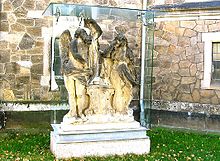Chronos
![]()
The title of this article is ambiguous. For other meanings, see Chronos (disambiguation).
![]()
This article or section needs revision. More details should be given on the discussion page. Please help improve it, and then remove this tag.
Chronos (ancient Greek Χρόνος chrónos, German 'time') is the personification of time in Greek mythology. He is partly identified with the Titan Kronos. He symbolizes the passage of time and also the lifetime.

Waiting Chronos by Santo Saccomanno (1876), sculpture in the monumental cemetery Staglieno, Genoa
Mythology
Chronos comes from the myths of the Orphics, an ancient religious current in Greece, southern Italy and the Black Sea coast (from about the 6th / 5th century BC). According to this, he himself emerged from the dark chaos and, as the creator god, produced the silver world egg from the Aither. This in turn gave rise to Phanes, the god of light, who was particularly revered by the Orphics and was identified with Helios, but also with Eros and Dionysus.
Chronos plays an important role in the speculative poetry of the Orphics, but there never was a cult of Chronos in antiquity. There was also no fixed iconography and no representations of Chronos in archaic and classical Greek art. The oldest known representation is on a relief from Hellenistic times. There Chronos appears as a beardless figure with large wings. Chronos was the personification of an abstract concept and not a component of Greek popular religion. The same applies to Phanes, who also had no popular cult.
Representation in art
Since about the middle of the 14th century, Chronos has been depicted in the visual arts as a bearded old man with a sickle and an hourglass (hourglasses did not exist until this time); for example, in the oil painting The Wheel of Destiny by Walter Crane.
In the Baroque period, a female figure often appears next to him, the lamenting woman or the mourner, as for example in the monument Chronos and the Mourner in the churchyard of the Friedenskirche in Radebeul-Kötzschenbroda.
· 
Bartolomeo Altomonte: The four seasons, paying homage to Chronos (1737)
·
The Chronos Fountain (1770-1772) on Hofstraße in Würzburg by Johann Peter Wagner
· 
Chronos by Hans Latt (1904), cemetery IV of the parish of Jerusalem and New Church

Baroque monument Chronos and the mourner in Radebeul
Search within the encyclopedia
